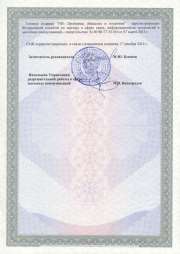|
MAIN PAGE
> Back to contents
Culture and Art
Reference:
Al'-Tamimi S.M., Pankina M.V.
Ornament in the architecture of mosques in Jordan: traditions and innovations
// Culture and Art.
2024. № 4.
P. 74-88.
DOI: 10.7256/2454-0625.2024.4.69044 EDN: VIURFK URL: https://en.nbpublish.com/library_read_article.php?id=69044
Ornament in the architecture of mosques in Jordan: traditions and innovations
Al'-Tamimi Sakher Mukhammed
ORCID: 0000-0002-8428-7824
Postgraduate student, Department of Art History and Museology,
Ural Federal University named after the First President of Russia B.N. Yeltsin
620002, Russia, Sverdlovsk region, Yekaterinburg, Lenin str., 51, office 426

|
sakher.tameme@yahoo.com
|
|
 |
|
Pankina Marina Vladimirovna
ORCID: 0000-0001-6971-7497
Doctor of Cultural Studies
Professor, Department of Cultural Studies and Design, Ural Federal University named after the First President of Russia B.N. Yeltsin
620002, Russia, Sverdlovsk region, Yekaterinburg, Mira str., 19, of. I-314

|
m.v.pankina@urfu.ru
|
|
 |
|
DOI: 10.7256/2454-0625.2024.4.69044
EDN: VIURFK
Received:
20-11-2023
Published:
06-05-2024
Abstract:
The object of the study is ornaments in the architecture of ancient and modern mosques. Using the example of mosques in Amman (Jordan), traditional ornaments are considered from the point of view of their purpose, content and symbolism, location and plastic organization. The compositional techniques, stylization methods, images used in ornaments are analyzed. In the modern architecture of mosques, continuity in approaches to decoration is combined with the active use of modern technologies in the construction and interpretation of ornaments, their embodiment in the material. Since there are strong changes in the space-planning solutions of mosques in connection with modern functional tasks, it is ornaments that are the most important means of identifying religious buildings. New interpretations of the visual language and the purpose of the decoration of mosques are due to the processes of globalization and the use of computer technologies for the design of structures. The authors conclude that it is necessary to follow the canons of Islamic ornamental motifs when using them in modern architecture, especially in religious buildings. By offering engineering and artistic innovations, architects must preserve the structure, plasticity and symbolism of ornaments in which the philosophy of Islam accumulates.
Keywords:
Islamic architecture, architecture of mosques, mosques of Amman, Islamic ornament, geometric ornament, girih, islimi, symbolism, symbolism of ornament, traditions
This article is automatically translated.
You can find original text of the article here.
Introduction For many centuries, ornaments were not just decorative elements in Islamic architecture, but formed an integral part of it, as they played an important symbolic role, denoting the belonging of the building to the Islamic civilization. In architecture, as well as in decorative and applied arts, geometric and floral ornaments with very complex compositional and color solutions were used. In the Arab-Islamic and Jordanian civilizations, the ornament has acquired a special meaning and a unique personality. There are no similar analogues in the architecture of other civilizations, when ornaments actually became the main expressive means of architecture, covering almost the entire area of the facade and interior [9]. The problem of the research is the use of Islamic geometric ornaments in modern mosque architecture outside the framework of their traditional construction, symbolic meanings and functional tasks. Architects (often invited foreign specialists) propose and apply new plastic techniques, computer technologies in shaping the decoration of mosques. Visual interpretation can change the understanding of the symbolic and meaningful role of ornaments. In the situation of rethinking the three-dimensional solution of modern mosques, it is necessary to study in depth the roots of Islamic motives from the point of view of the meanings and principles of shaping inherent in them. The purpose of the study is to analyze the traditional methods of construction and composition of ornaments, their symbolism and use in the decoration of mosques. Using the example of modern mosques in Amman (Jordan) to show new approaches to the use of ornaments in terms of their purpose, content and symbolism, location on the facade and in the interior, plastic organization of the form. To identify new intellectual prerequisites for the revival of the role of decoration in modern architecture in Jordan for the organic connection of the past with the present, to achieve sustainable development of architecture based on traditions. Research methods: historical approach; analysis of the aesthetic component of mosque architecture; comparative analysis of ornaments in mosque architecture; compositional and stylistic analysis of the decor of modern mosques in Amman; systematization and generalization of empirical material; field research; interviews with architects; photo fixation. Ornament in the culture of Islam In the culture of ancient peoples, the ornament was a visual reflection of the surrounding world, a symbolic description, a sum of meanings about the world order, its order and values. The decorative elements of plants, animals and landscape are very similar in the art of different regions, but the artistic style and application, interpretation of each of these elements differed, and also changed from epoch to epoch. Aesthetic and artistic tasks were not specifically set for the masters. Abstraction, generalization, stylization of natural forms and phenomena, their transformation into iconic signs, metaphors, rhythmic organization in an ornamental row or on a plane, facilitated the process of decorating objects, enhanced the expressiveness of the image, facilitated their understanding. The subordination of the pictorial series to the shape of objects emphasized their special meaning, were a talisman, part of the ritual [5]. Islamic art refers to the civilization and culture of a large group of people united by faith in Islam, it had to correspond to the spirit, philosophy and teachings of Islam [8; 12; 14]. Since it is forbidden in Islam to depict a person and any other living being, in Arabic art ornament became the most important image and decoration, unlike European decorative and applied art, where it had a more auxiliary, formal meaning [6, pp. 517-524; 15]. Islam is not just a religion, it is a way of life, so there is no clear separation between secular and religious in art, the ornament was used not only for religious purposes, but was present in the daily life of Muslims. The ornament in Islam is very diverse in shape and color, meaningful and deep in content. Its basis is symbols and signs [13; 14]. There are two styles of Islamic ornament: geometric (girih, from Persian knot) and vegetable (islimi, from Persian bindweed, spiral). Girih was used mainly for the decoration of mosques and large books, where stylized polygonal figures emphasized perfection, greatness and power, the unattainability of heights, isolation from earthly existence. We find Islimi in the decoration of books, clothes and household utensils, in the interiors of mosques. The endless variety of its variants, a small change in each subsequent curl in one row reveals the idea of the continuous development of natural forms, accessibility, warmth, proximity and softness of the surrounding world. Sometimes these styles were mixed, for example, a large geometric girich grid was filled with woven small vegetable curls [8]. Calligraphic writing (quotes from the Quran and Hadith) They were also turned into an ornament or inscribed in compositions with girih (kufic rectangular font) and islimi (rounded cursive naskh). In Islamic art (in particular, in ornament), forms express the image of infinity and incompleteness at the same time. Patterns fill the surface of an object or structure with a solid carpet. This principle is called "horreur vacui" (fear of emptiness), it expresses the main idea of Muslim art – Allah is omnipresent, we do not see him, he is simultaneously "nowhere and everywhere". The dot or void in the center of the image signified the Creator, from whom the whole world originates. The Europeans called a complex Arabic pattern, built on the basis of an accurate mathematical calculation, based on the repetition of one or more elements of the pattern – arabesque (from French arabesque – "Arabic"). The rhythm of the Arabesque is consonant with Arabic poetry and music, illustrates the idea of an infinite universe [1]. The arabesque pattern can be placed on a surface of any shape and size (on a building, book, tableware, jewelry, etc.), it can be stopped or continued at any point, while maintaining integrity and rhythm [7; 8]. Ornament in the architecture of ancient mosques in Jordan
At the beginning of the 7th century, when the teachings of the Prophet Muhammad began to spread rapidly throughout the Arab East, the early buildings of the Arabs were preserved Roman and Byzantine buildings adapted for life and use, or buildings were built on ruins and from the materials of ancient structures. The new civilization was actively developing and forming a unique style of the subject-spatial environment. In order to convey the religious principles of Islam, architects and builders began to include divine messages in the form of ornaments in Arab-Islamic architecture. It was the ornament that was the most important means of indicating the belonging of household items and architectural objects to the culture of Islam [11, pp. 154-173]. The mosque has always been both a meeting place and a madrasah school, dialectically combining mercy and severity. On the facades, an ornament in the Girih style and, accordingly, a Kufic font for inscriptions were more often used. In the interior, the soft forms of islimi and naskha freely filled fragments of walls, framed openings, created an atmosphere of unity, brought man closer to God [9]. A rectangular, strict girih can be found only above the mihrab (the niche in the wall where the imam says the prayer is directed towards Mecca). Muslims could see the girih only when they stood up for prayer, later, during prayer, conversations and classes, the ornament did not come into view [7]. Ornaments on the facades and in the interior of mosques were carved in stone, made on ganch tiles, painted with paints. Wood and brick in the architecture of mosques can be found very rarely [4]. Ornament in the modern architecture of Amman Mosques: interpretation of traditions Throughout its history, Jordan has been subjected to many turbulent factors, but has proven its ability to perceive the culture of many peoples while maintaining its identity [3]. Most of the engineers who worked in Jordan in the forties and sixties of the twentieth century were graduates of Fuad I University in Giza (Egypt) or the American University in Beirut (Lebanon). At that time, mainly residential, industrial and administrative buildings were erected. Architecture increasingly corresponded to European trends, but lost its national features. The design strategies were based on global knowledge and local application, as well as on the interest of most young specialists in Western architecture [2]. Foreign architects began to be invited to the Jordanian capital Amman to design significant facilities, the city accepted and absorbed various architectural models, and world-class structures began to appear. The shaping of buildings was based on abstract elements of simple geometric shapes. The traditional stone was replaced by concrete, reinforced concrete, metal, marble and mosaic were used for facade cladding. When foreign craftsmen began to imitate traditional local architecture in administrative and religious buildings, they used some vocabulary of heritage without deep knowledge of its content and concept. The first attempts to present new models of Arab architecture were unsuccessful, but they made us think about the importance of studying heritage and preserving local identity [2]. Historian Abu Ghanima Ali wrote that the development of modern architecture in Jordan was associated with the search for an integrated concept of the role of the architect, the creation of a Syndicate of Engineering Professions [2]. In the eighties of the XX century, young architects in their projects began to actively turn to the Islamic heritage, they demonstrated a love for stone, developed a modern architectural language in the context of national traditions [10]. The authors of the article conducted a field study of many religious buildings in Amman, among them: mosques of King Abdullah I, King Hussein, Al-Huda, Al-Qaluti, Al-Nurin, Al-Hamshari. Architectural details and elements, the nature of the ornaments, their location on the facade and in the interior, purpose and symbolism were studied. A comparative analysis of the decor of modern buildings with traditional Islamic ornaments is carried out. Common techniques in design solutions were highlighted: ornaments are placed on the exterior walls – along the perimeter of the dome and around the portals, in the interior – on the dome and at its base, around windows and doors, with a solid carpet on the floor, decorated with mihrab and minbar. Let's consider the location and features of ornaments in the architecture of mosques using the example of some structures. The Mosque of the Martyr King Abdullah I bin al-Hussein (1989, Amman, architect Jan Chek) was built under the supervision of local Jordanian experts as a comprehensive Islamic cultural center (see Figure 1). The mosque consists of an octagonal prayer hall with a large dome (height 31 m, diameter 35 m), two minarets and two courtyards, a triple portico. 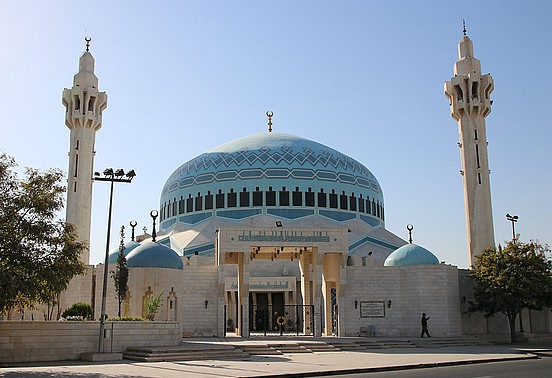
Fig. 1. Mosque of the Martyr King Abdullah I bin al-Hussein, Amman, Jordan. Photo by the author The dome is decorated with a blue-blue geometric mosaic ornament, which symbolizes the sky. Simple geometric motifs of large and small sizes are arranged vertically and horizontally on the walls, and there are inscriptions from the Koran on the porticos. The windows on the outside have a simple rectangular geometric shape with squares above them, repeating along the perimeter of the dome, they form an ornament (see Fig. 2). From the outside they look like ordinary glass, but from the inside they are colored stained glass windows with the image of stars.  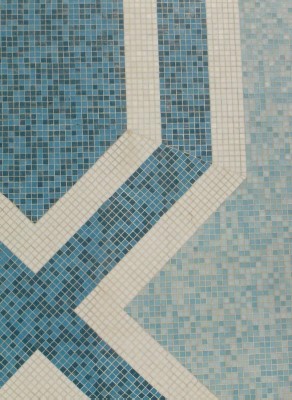
Fig. 2. Geometric ornament on the portico and dome of the mosque of King Abdullah I. Source: universes.art
In the interior, the ornament covers almost all surfaces. The mihrab (a part of the qibla wall separated from the main wall of the mosque) has a large-scale muqarna compared to the size of the small mihrab, made of stone with gilded inscriptions in addition to geometric decorations with small details. The wooden minbar, located next to the mihrab, reflects the Mamluk style, decorated with geometric ornaments with stars. Carved wooden panels similar in shape to mashrabi are installed along the walls, wooden cabinets and doors form a single whole with them (see Fig. 3, 4). We see hexagonal and decagonal geometric grids, similar in shape to a circle, decorative stripes forming a geometric ribbon, which echoes the solutions on the facade of the mosque.  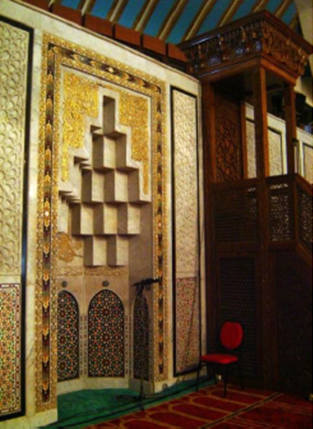 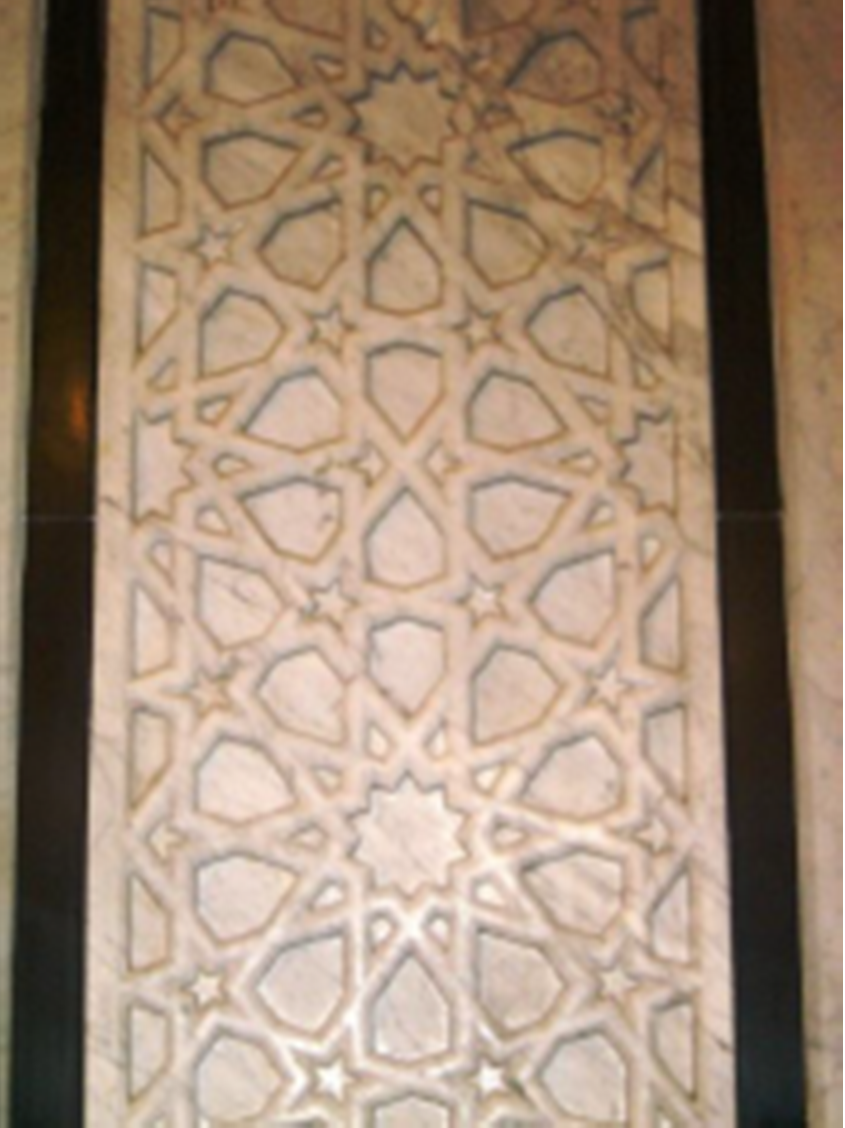
Fig. 3. Ornaments in the interior of the King Abdullah I mosque on the Qibla wall. Photo by the author 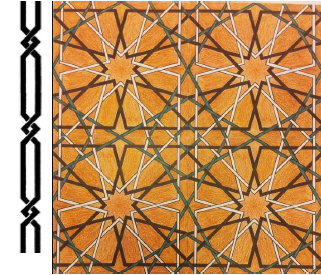 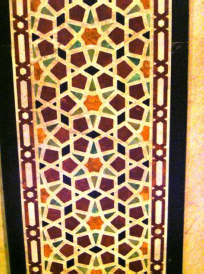 4. Colorful geometric ornaments on the wall of the qibla in the mosque of King Abdullah I. Photo by the author, sketch by the architect The main doors of the mosque have geometric decorative star carvings based on a pentagonal geometric grid (see Fig. 5).   Fig. 5. Geometric ornament on the doors of the King Abdullah I Mosque. Photo by the author, sketch by the architect The dome in the interior is decorated with golden lines in the form of a star, which symbolizes the rays of sunlight illuminating the 99 names of Allah. The rays go from the center to the stained glass windows, which also depict multicolored stars (see Fig. 6).  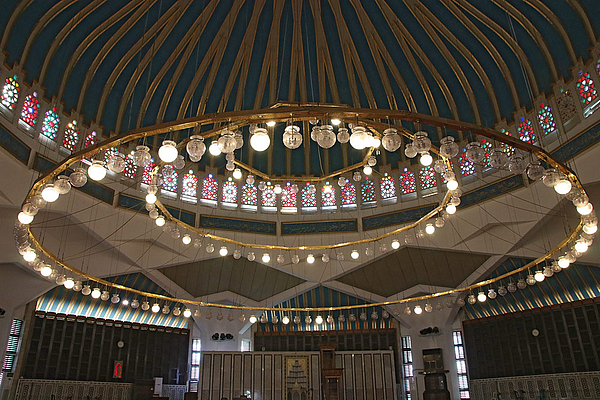
Fig. 6. The decoration of the dome in the interior of the mosque of King Abdullah I. Photo by the author The floor is completely covered with a carpet with a solid geometric pattern of stripes with stars to unite and immerse the worshippers in the mystery of the process. Despite the fact that it was built relatively recently, in 1989, the mosque of King Abdullah I corresponds to the traditional features of Islamic mosques as much as possible in terms of spatial planning and decor. We see a different approach to the decoration of mosques in the Al-Qaluti Mosque (1999, Amman, architects Ismail Tahan and Zaher Bushnak). Despite the conciseness of the forms, the architects undertook to present both the modernity of the stone building and the traditional decorative Islamic art on the facade and in the interior [10]. The overall solution of the mosque does not correspond to the traditional principles of building a plan, such as the presence of an inner courtyard, porticos, and its 17-meter-high minaret was built separately from the main building and dome (see Fig. 7). The architects moved away from stereotypes in the design of the mosque, from the presence of arches, mukarnes and other well-known elements, proposed clear and simple modern solutions. Therefore, it is the decor that is the element that creates the image of architecture and indicates belonging to Islamic architecture. 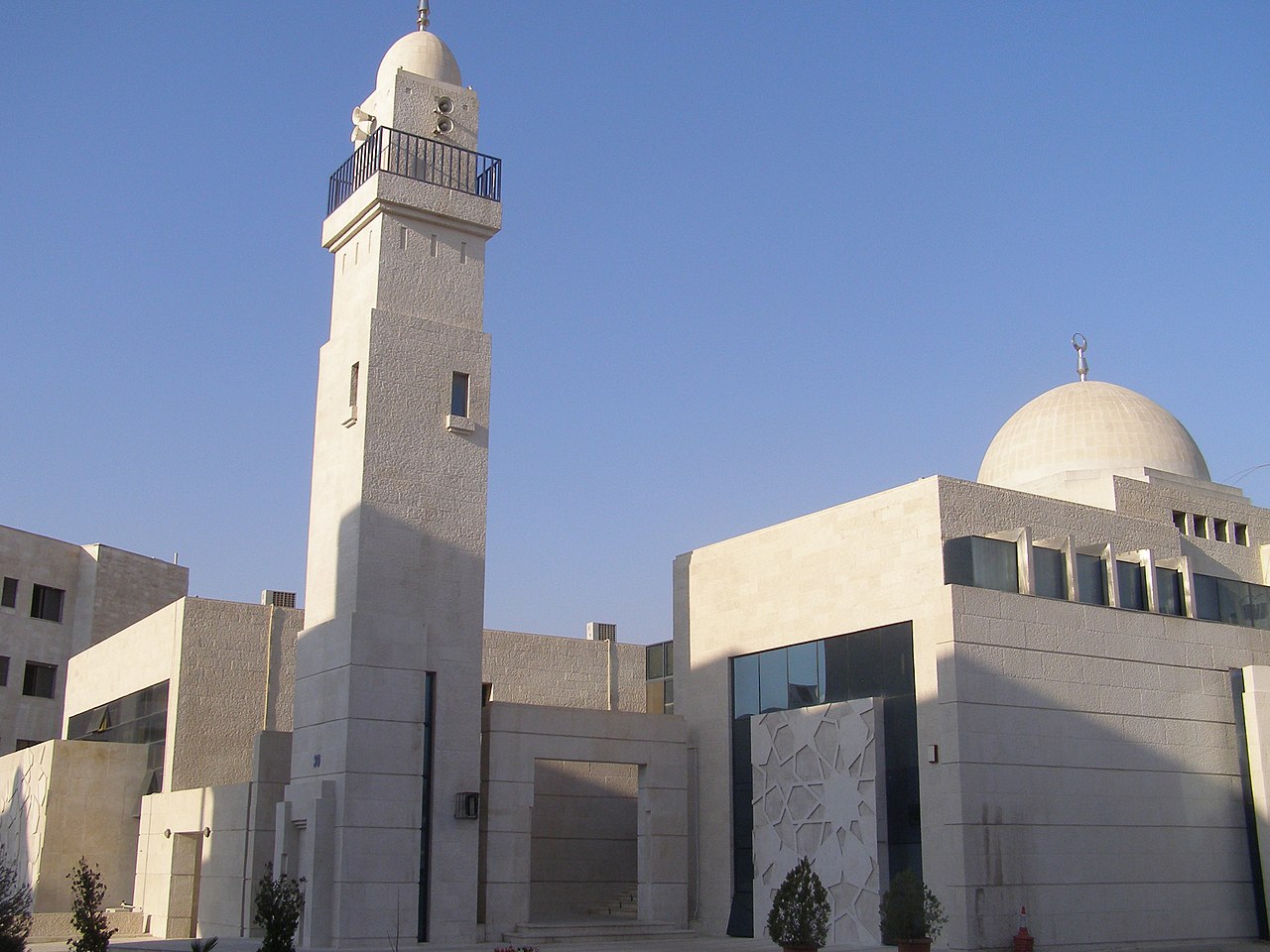
Fig. 7. Al-Qaluti Mosque, Amman, Jordan. Photo by the author From an interview with Al-Tamimi Saher M. M. with the architect of the mosque Ismail Tahan: "Geometric decor is present on the two main walls of the facade, protruding from the glass wall. The drawing was repeated on the second wall, but on a larger area and with horizontal expansion and dissolution, disappearance of the drawing. The use of glass behind the two walls that contain the decor creates a background, emphasizes the importance of the protruding wall, reduces the massiveness of the stone blocks, integrates transparency into them and helps to create the necessary lighting inside the mosque." We see on the walls of the facade a dissolving and unfinished ornament, stars of irregular shape, which was not found in traditional Islamic ornament (see Fig. 8, 9, 10). 
Fig. 8. The main facade of the Al-Kaluti mosque with an indication of the location of the ornaments. Source: architect Ismail Takhan's project
 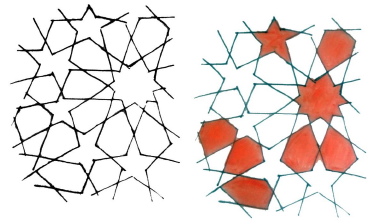
Fig. 9. The first smaller wall of the Al-Qaluti mosque and the scheme of its ornament. Source: project by architect Ismail Takhan and photo by the author 
10. The second largest wall of the Al-Qaluti Mosque. Photo by the author The architects do not care about decorating the dome, it is smooth and simple from the outside with a crescent moon at the top. The doors and windows are made laconically, do not have geometric decorations. In the interior of the mosque, the ornaments are repeated on the walls, but on other materials and using color. Wood is used to decorate interior walls, painted in dark tones to emphasize the importance of decoration and give it contrast. There are no decorations on the vault and ceiling so as not to distract the worshippers during prayer. An ornamental pattern of stars with twelve rays on carpets and stone slabs is used on the floors, which symbolizes the cosmos (see Fig. 11). Changing the scale of the drawing creates a human scale for the worshippers.  
11. Ornaments on the floor and carpet in the Al-Qaluti Mosque. Photo by the author The Al-Hamshari Mosque (2011, Amman, engineer Samir Maghrabi, architectural group Atelier White from Dubai) does not have a dome, which is a rejection of traditions, an expression of modernity, while preserving such irreplaceable elements as the minaret (there is only one minaret with a height of 22 meters of a prismatic shape) (see Fig. 12). The spatial planning solution is based on the principles of displacement, shifts, overlays, spatial "gaps" [3]. 
Fig. 12. Al-Hamshari Mosque, Amman, Jordan. Photo by the author Large areas of glass (without decoration) and stone actively contrast on the facade. The building looks like a secular structure. It is the geometric decor that becomes the main means of indicating that the building belongs to Islamic culture. The ornaments on the facade are presented in two versions: a perpendicular composition of a kufic rectangular font and a free interpretation of girih in the form of an almost chaotic, irregular-angled network of lines forming stars that partially do not fit on the wall plane. The "wrong" ornament, as conceived by the architects, solves functional and aesthetic problems – creates a human scale, zones the space, decorates the wall, indicates the ethnicity of the building. These lines extend to the adjacent walls and entrances, provide integration and unity between them, create a holistic picture, diversity and geometric rhythm (see Fig. 13, 14). 
13. The southeastern facade of the Al-Hamshari Mosque. Source: Atelier White Group project 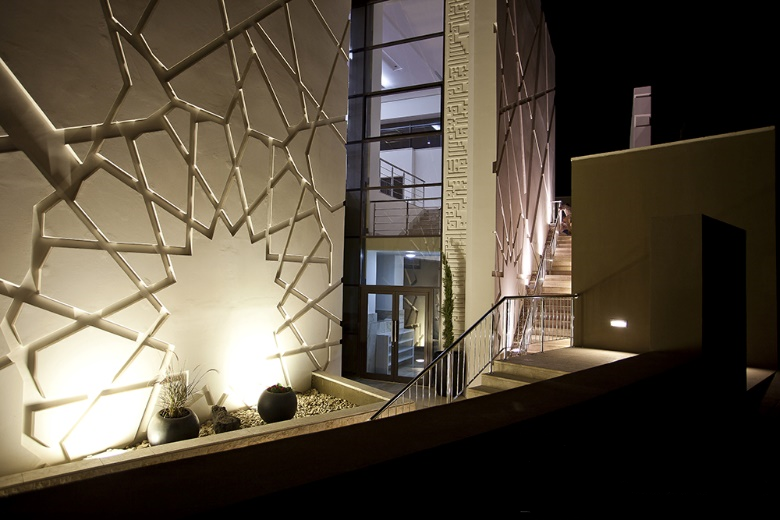
Fig. 14. Relief of the ornament on the southeastern facade of the Al-Hamshari mosque. Photo by the author Geometric inscriptions similar to the motifs on some of the exterior walls and on the minaret are used in the decoration of the ceiling, especially in front of the mihrab area. The modern-shaped chandelier represents a star. The designers deliberately added another style to the Islamic decor, namely quite realistic floral motifs decorating the carpet. Mihrab and minbar have a modern design integrated with the design of the mosque and embodying the same idea of development, they are made of wood and glass, decorated with abstract Islamic geometric motifs scattered as on the facades. The qibla wall is decorated with geometric ornaments with straight perpendicular lines, which symbolize balance and order, as well as the images on the ceiling (see Fig. 15). 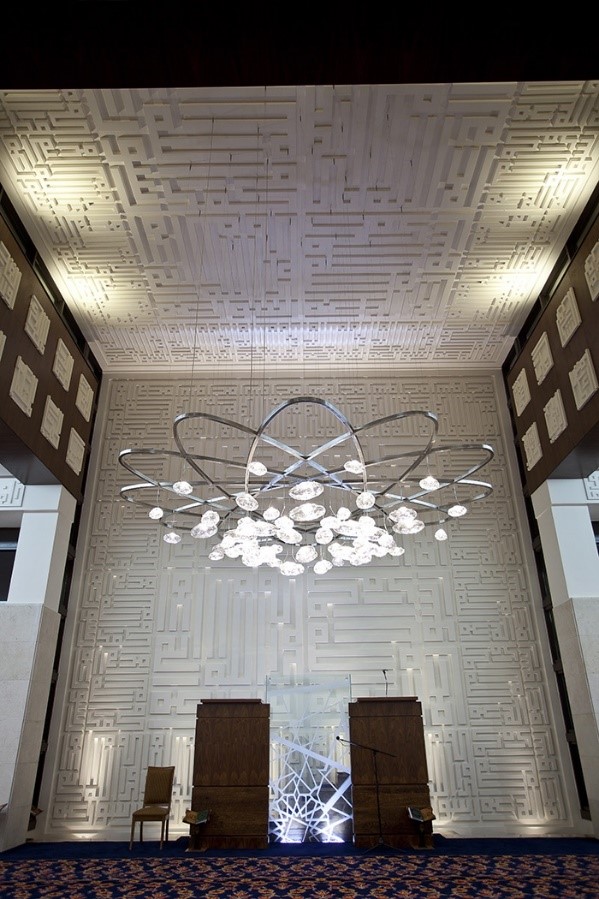 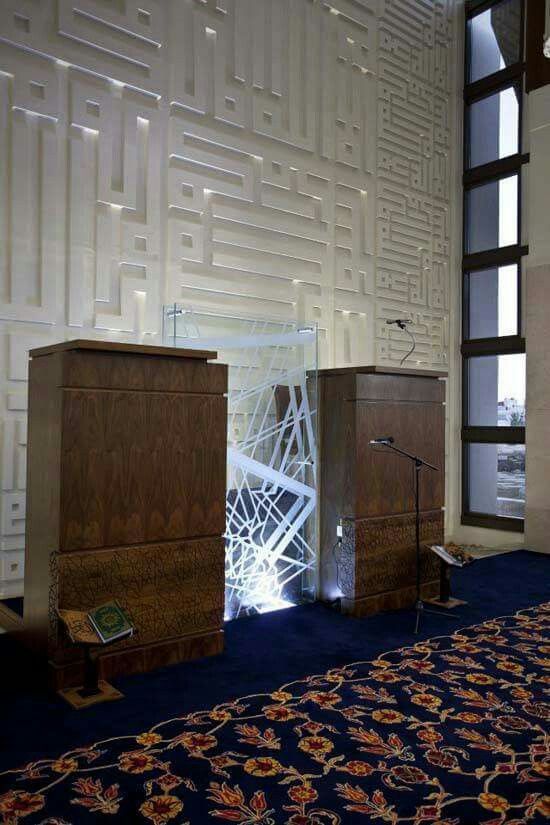
Fig. 15. Details of the geometric decoration used on the wall of the qibla, mihrab and Minbar inside the Al-Hamshari mosque, Photo by the author Conclusions In modern mosques, architects actively use modern technologies in the construction of ornaments, their embodiment on various surface materials. Using the example of mosques in Amman (Jordan), we see how boldly designers interpret traditional ornaments. While preserving their main metaphor (the unattainability of heights, infinity, greatness and power) and purpose (to indicate belonging to Islamic culture, to decorate the most important elements of the facade and interior), the geometry of the construction of the ornament grid, plastic organization, location, and therefore meanings, symbolism undergo a change. The infinity and perfection of ornaments, characteristic of Girih and islimi, are interpreted into flexibility, incompleteness, dissolution, an irregular geometry of the grid of construction, stars appears [13]. Architects simplify the ornament, "play" with its scale: from very large expressive elements visible from afar, they gradually move to small-scale human elements. Mosques are designed in modern styles (modernism, minimalism, deconstructivism, high-tech, etc.), the building may not have a dome. The minaret is more often a monolithic pillar with loudspeakers without an internal or external staircase, the muezzin does not climb it to call the faithful to prayer. In modern mosques in Amman, the interior, its main elements mihrab and minbar, carpet on the floor are decorated more than the facade. The locations of the ornaments are changing and their number is decreasing. There are strong changes in the spatial planning solutions of mosques in connection with modern functional tasks, therefore, ornaments are the most important means of identifying religious buildings. New interpretations of the visual language and the purpose of the decoration of mosques are due to the processes of globalization and the use of computer technologies for the design of structures. By offering engineering and artistic innovations, architects must preserve the structure, plasticity and symbolism of the ornaments in which the philosophy of Islam accumulates. It is necessary to follow the canons of Islamic ornamental motifs when using them in modern architecture, especially in religious buildings.
References
1. Abdel-Gawad, & Tawfiq Ahmed. (2010). History of Islamic architecture. Anglo-Egyptian Library, Cairo, Yarmouk University, Irbid. Retrieved from http://hip.jopuls.org.jo
2. Abu Ghanima, Ali. (2002). "The City of Amman". A generation of pioneers in architecture. Jordan University. Retrieved from https://artsdesign.ju.edu.jo
3. Al-Tamimi S. M. M., & Pankina M. V. (2022). Reflection of globalization processes in the cult architecture of Jordan. Culture and Civilization, 12(2A), 22-36.
4. Butkevich, L.M. The history of ornament. Retrieved from http://royallib.ru/read/butkevich_lyubov/istoriya_ornamenta_uchebnoe_posobie.html#0
5. Vlasov, V.G. (2009). On the definition of the concept of "decorative" in various types of fine art. Architecton: news of universities, 2(26). Retrieved from http://archvuz.ru/2009_2/16
6. Vlasov, V. G. (2007). Ornament. New Encyclopedic Dictionary of Fine Art. In 10 vols. St. Petersburg: ABC Classics. – Vol. VI. – pp. 517-524.
7. Ornament in the visual culture of Islam. Retrieved from https://islam.ru/content/kultura/31083
8. Sacred meanings of Islamic ornament. Retrieved from https://islam-today.ru/obsestvo/obrazovanie/sakralnye-smysly-islamskogo-ornamenta
9. Grube, Ernst. (1984). Architecture of the Islamic World: Its History and Social Meaning. Publisher Thames & Hudson. London.
10. Ibrahim, Abdelbaki Mohamed (Ed). 1999. Genuine and Contemporary, A private Experience, Jaafar Tukan. In Alam al-Bina. Cairo: Center for Planning and Architectural Studies, 16-17/207. Retrieved from https://www.archnet.org/publications/4712
11. Jones, Owen. The Grammar of Ornament: A Visual Reference of Form and Colour in Architecture and the Decorative Arts-The Complete and Unabridged Full-Color Edition (pp. 154-173). Princeton University Press, 2016. Retrieved from https://doi.org/10.2307/j.ctvc77mhw
12. الغول ،الي(2006) اللسية اللللهندسي اللدائرةاي العمارةاالفنون الإسلامية Al-Ghul, Ali. (2006). The philosophy of the geometric shape of the circle in architecture and Islamic art.
13. المالكي، قبيلة( 2002 )،الهندسة والرياضيات في العمارة دار الصفا للطباعة والنشر والتوزيع، عمان ،الأردن Al-Maliki, Qibla (2002). Engineering and Mathematics in Architecture, Dar Al-Safa for Printing, Publication and Distribution, Amman, Jordan.
14. الواير ─حيى (2000)، موسوعة عناصر العمارة الإسلامية، أربعة مجلدات، مكتبة مدبولي Vizier Yahya. (2000). Encyclopedia of Elements of Islamic Architecture, four volumes, Madbuli Library. Jordan.
15. المفتي أحمد( 1999)، الزخارف الهندسية الإسلامية، دار دمشق ،دمشق Mufti Ahmad. (1999). Islamic Geometric ornaments, Damascus House, Damascu.
Peer Review
Peer reviewers' evaluations remain confidential and are not disclosed to the public. Only external reviews, authorized for publication by the article's author(s), are made public. Typically, these final reviews are conducted after the manuscript's revision. Adhering to our double-blind review policy, the reviewer's identity is kept confidential.
The list of publisher reviewers can be found here.
The author submitted his article "Ornament in the architecture of mosques in Jordan: traditions and innovations" to the magazine "Culture and Art", in which a study of the traditional element of decorating Islamic architecture as an example of decorative and applied art of Oriental culture was conducted. The author proceeds in the study of this issue from the fact that for many centuries ornaments were not just decorative elements in Islamic architecture, but formed an integral part of it, since they played an important symbolic role, denoted the belonging of the building to the Islamic civilization. In the culture of ancient peoples, the ornament was a visual reflection of the surrounding world, a symbolic description, a sum of meanings about the world order, its order and values. The relevance of this study is due to the fact that in the Arab-Islamic and Jordanian civilizations, the ornament has acquired a special meaning and a unique personality. There are no similar analogues in the architecture of other civilizations, when ornaments actually became the main expressive means of architecture, covering almost the entire area of the facade and interior. In the situation of rethinking the spatial solution of modern mosques, it is necessary to study in depth the roots of Islamic motives from the point of view of the meanings and principles of shaping inherent in them. The methodological basis was an integrated approach, including a historical approach; analysis of the aesthetic component of mosque architecture; comparative analysis of ornaments in mosque architecture; compositional and stylistic analysis of the decor of modern mosques in Amman; systematization and generalization of empirical material; field research; interviews with architects; photo fixation. The empirical base includes images and descriptions of traditional and modern mosques in Jordan. The purpose of this work is to analyze the traditional techniques of construction and composition of ornaments, their symbols and use in the decoration of mosques. To achieve this goal, the author sets the following tasks: using the example of modern mosques in Amman (Jordan) to show new approaches to the use of ornaments in terms of their purpose, content and symbolism, location on the facade and in the interior, plastic organization of the form; to identify new intellectual prerequisites for the revival of the role of decoration in modern architecture in Jordan for the organic connection of the past with to achieve the sustainability of the development of architecture based on traditions. Unfortunately, the author has not carried out an analysis of the scientific validity of the studied problem, which makes it difficult to make a conclusion about the scientific novelty of the study. The author explains the widespread use of ornament in Islamic culture by the religious prohibition of depicting living beings. In addition, Islamic culture is initially sacred, there is no division into secular and religious, so the ornament is present both in the decoration of religious buildings and in the daily life of Muslims. The author identifies two traditional styles of Islamic ornament: geometric (girih, from Persian knot) and vegetable (islimi, from Persian bindweed, spiral). The endless variety of their variants is deeply symbolic. Based on historical analysis, the author presents the thesis that during the period of the initial spread of Islam, ornament played the role of a translator of religious principles, as architects and builders of mosques began to include divine messages clothed in the form of ornaments in Arab-Islamic architecture. On the facades, an ornament in the Girih style and, accordingly, a Kufic font for inscriptions were more often used. In the interior, the soft shapes of islimi and naskha freely filled fragments of walls, framed openings, created an atmosphere of unity, brought man closer to God. The author of the article conducted a field study of many religious buildings in Amman, among them: mosques of King Abdullah I, King Hussein, Al-Huda, Al-Qaluti, Al-Nurin, Al-Hamshari. Architectural details and elements, the nature of the ornaments, their location on the facade and in the interior, purpose and symbolism were studied. A comparative analysis of the decor of modern buildings with traditional Islamic ornaments is carried out. Common techniques in design solutions were highlighted: ornaments are placed on the exterior walls – along the perimeter of the dome and around the portals, in the interior – on the dome and at its base, around windows and doors, with a solid carpet on the floor, decorated with mihrab and minbar. In conclusion, the author presents a conclusion on the conducted research, which contains all the key provisions of the presented material. The author notes that in modern mosques, architects actively use modern technologies in the construction of ornaments, embodying them on various surface materials, designers boldly interpret traditional ornaments. While preserving their main metaphor and purpose, the geometry of the construction of the ornament grid, plastic organization, location, and therefore meanings and symbolism undergo changes. The author explains the new interpretations of the visual language and the purpose of the decoration of mosques by the processes of globalization and the use of computer technologies for designing structures. It seems that the author in his material touched upon relevant and interesting issues for modern socio-humanitarian knowledge, choosing a topic for analysis, consideration of which in scientific research discourse will entail certain changes in the established approaches and directions of analysis of the problem addressed in the presented article. The results obtained allow us to assert that the study of the unique culture of a certain people, its material and spiritual cultural heritage is of undoubted theoretical and practical cultural interest and can serve as a source of further research. The material presented in the work has a clear, logically structured structure that contributes to a more complete assimilation of the material. An adequate choice of methodological base also contributes to this. The bibliographic list of the study consists of 15 sources, which seems sufficient for the generalization and analysis of scientific discourse on the subject under study. The author fulfilled his goal, received certain scientific results that allowed him to summarize the material. It should be noted that the article may be of interest to readers and deserves to be published in a reputable scientific publication.
Link to this article
You can simply select and copy link from below text field.
|
|





